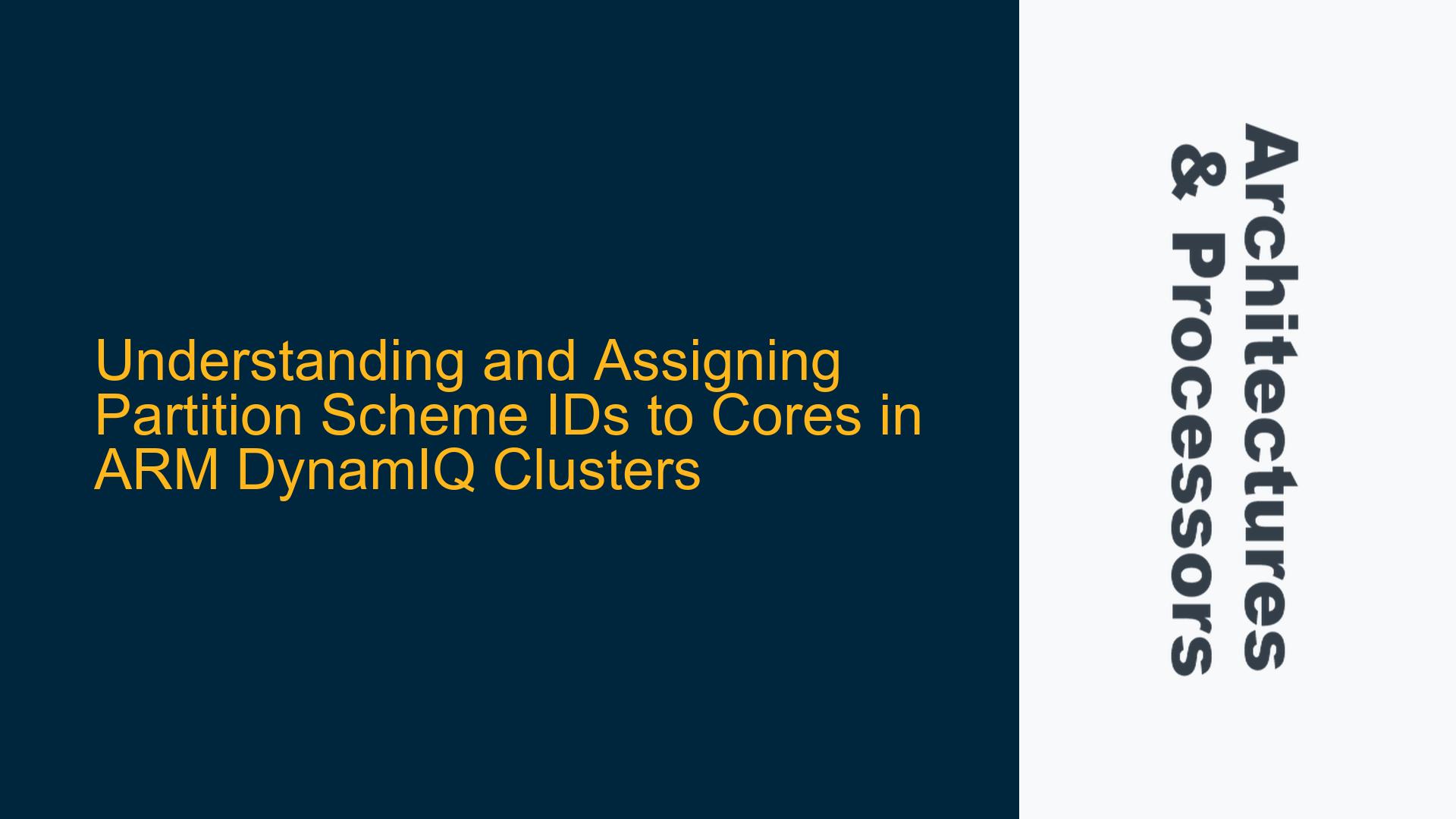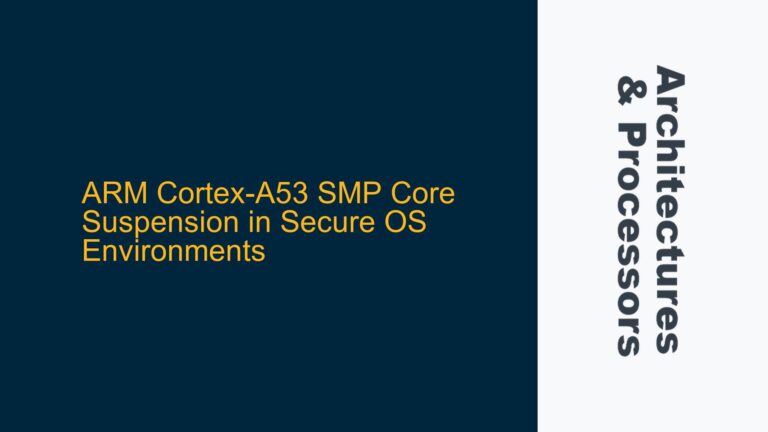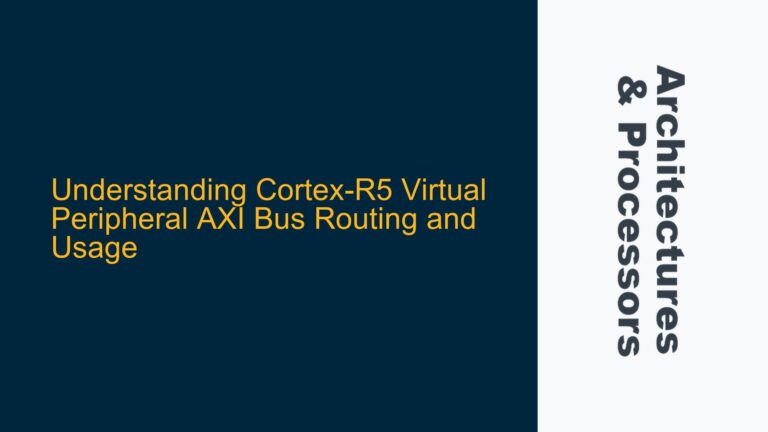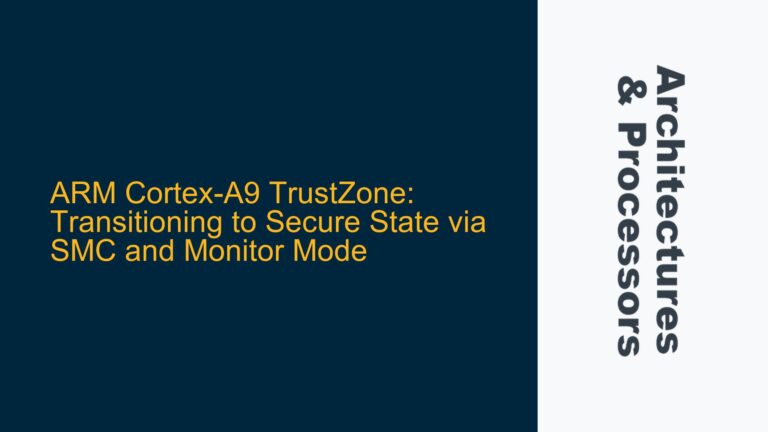ARM Cortex-A55 L3 Cache Partitioning and Core-to-Partition Scheme ID Mapping
The ARM Cortex-A55, as part of the DynamIQ Shared Unit (DSU), introduces a sophisticated mechanism for L3 cache partitioning. This partitioning is crucial for optimizing performance and resource allocation in multi-core systems. The L3 cache partitioning is managed through partition scheme IDs, which are assigned to each core within a cluster. The partition scheme IDs determine how the cache ways are allocated among the cores, ensuring that each core has access to a defined portion of the L3 cache.
The DynamIQ Shared Unit supports up to eight partition scheme IDs, and each core in the cluster must be assigned to at least one of these IDs. The mapping between cores and partition scheme IDs is not explicitly detailed in the ARM documentation, leading to confusion among developers. The core-to-partition scheme ID mapping is essential for configuring the cache partitioning scheme, which directly impacts the performance and efficiency of the system.
To understand the core-to-partition scheme ID mapping, it is necessary to delve into the architecture of the DynamIQ Shared Unit and the role of the L3 cache partitioning. The L3 cache is divided into multiple ways, and each way can be assigned to a specific partition scheme ID. The partition scheme IDs are then associated with the cores, allowing each core to access a specific set of cache ways. This mechanism ensures that the cache resources are allocated efficiently, preventing contention and improving overall system performance.
The assignment of partition scheme IDs to cores is typically managed through the system control registers. These registers allow the software to configure the partition scheme IDs for each core, defining the cache ways that each core can access. The exact configuration of these registers depends on the specific implementation of the ARM Cortex-A55 and the DynamIQ Shared Unit, and it is essential to refer to the technical reference manual (TRM) for the specific details.
Memory Management Unit (MMU) Configuration and Cache Partitioning
One of the primary causes of confusion in assigning partition scheme IDs to cores is the interaction between the Memory Management Unit (MMU) and the cache partitioning mechanism. The MMU is responsible for translating virtual addresses to physical addresses and managing the memory attributes, including cacheability. The cache partitioning mechanism, on the other hand, is responsible for allocating cache ways to specific partition scheme IDs.
The MMU configuration can influence the cache partitioning scheme, as the memory attributes defined in the MMU determine how the cache is used. For example, if a memory region is marked as non-cacheable in the MMU, the cache partitioning scheme will not apply to that region. Similarly, if a memory region is marked as cacheable, the cache partitioning scheme will determine how the cache ways are allocated for that region.
The interaction between the MMU and the cache partitioning mechanism can lead to unexpected behavior if not properly configured. For instance, if the MMU is configured to mark a memory region as cacheable, but the cache partitioning scheme is not correctly assigned to the cores, the cores may not have access to the expected cache ways. This can result in performance degradation and inconsistent behavior.
To avoid these issues, it is essential to ensure that the MMU configuration is aligned with the cache partitioning scheme. This involves carefully configuring the memory attributes in the MMU and ensuring that the partition scheme IDs are correctly assigned to the cores. The ARM Cortex-A55 TRM provides detailed information on the MMU configuration and its interaction with the cache partitioning mechanism, and it is crucial to refer to this documentation when configuring the system.
Configuring Partition Scheme IDs and Cache Ways in ARM Cortex-A55
The process of configuring partition scheme IDs and cache ways in the ARM Cortex-A55 involves several steps, including setting up the system control registers, configuring the MMU, and assigning partition scheme IDs to the cores. The following steps provide a detailed guide on how to configure the partition scheme IDs and cache ways in the ARM Cortex-A55.
Step 1: Understanding the System Control Registers
The system control registers in the ARM Cortex-A55 are responsible for managing the cache partitioning scheme. These registers allow the software to configure the partition scheme IDs and assign them to the cores. The exact configuration of these registers depends on the specific implementation of the ARM Cortex-A55 and the DynamIQ Shared Unit, and it is essential to refer to the TRM for the specific details.
The system control registers include the following key registers:
-
L3 Cache Partitioning Control Register (L3PCR): This register is used to configure the partition scheme IDs and assign them to the cores. The L3PCR allows the software to define the number of partition scheme IDs and the cache ways allocated to each ID.
-
L3 Cache Partitioning Scheme ID Register (L3PSIDR): This register is used to assign partition scheme IDs to the cores. The L3PSIDR allows the software to specify the partition scheme ID for each core in the cluster.
-
L3 Cache Partitioning Way Mask Register (L3PWMR): This register is used to define the cache ways allocated to each partition scheme ID. The L3PWMR allows the software to specify the cache ways that are available for each partition scheme ID.
Step 2: Configuring the MMU
The MMU configuration is critical for ensuring that the cache partitioning scheme is correctly applied. The MMU must be configured to mark the memory regions as cacheable, and the memory attributes must be aligned with the cache partitioning scheme. The following steps provide a guide on how to configure the MMU:
-
Define the Memory Regions: The first step in configuring the MMU is to define the memory regions that will be used by the system. This involves specifying the base address, size, and memory attributes for each region.
-
Set the Memory Attributes: The memory attributes determine how the memory regions are accessed and cached. For the cache partitioning scheme to be effective, the memory regions must be marked as cacheable. The memory attributes can be set using the MMU translation tables.
-
Align the MMU Configuration with the Cache Partitioning Scheme: The MMU configuration must be aligned with the cache partitioning scheme to ensure that the cache ways are correctly allocated. This involves ensuring that the memory regions marked as cacheable are assigned to the correct partition scheme IDs.
Step 3: Assigning Partition Scheme IDs to Cores
The final step in configuring the partition scheme IDs is to assign them to the cores. This involves setting the L3PSIDR to specify the partition scheme ID for each core in the cluster. The following steps provide a guide on how to assign partition scheme IDs to cores:
-
Determine the Partition Scheme IDs: The first step is to determine the partition scheme IDs that will be used in the system. The ARM Cortex-A55 supports up to eight partition scheme IDs, and each core must be assigned to at least one of these IDs.
-
Set the L3PSIDR: The L3PSIDR is used to assign partition scheme IDs to the cores. The L3PSIDR allows the software to specify the partition scheme ID for each core in the cluster. The exact configuration of the L3PSIDR depends on the specific implementation of the ARM Cortex-A55 and the DynamIQ Shared Unit, and it is essential to refer to the TRM for the specific details.
-
Verify the Configuration: Once the partition scheme IDs have been assigned to the cores, it is essential to verify the configuration to ensure that the cache ways are correctly allocated. This can be done by testing the system and monitoring the cache usage.
Step 4: Testing and Optimization
After configuring the partition scheme IDs and cache ways, it is essential to test the system to ensure that the cache partitioning scheme is working as expected. This involves running performance tests and monitoring the cache usage to identify any potential issues. The following steps provide a guide on how to test and optimize the cache partitioning scheme:
-
Run Performance Tests: The first step in testing the cache partitioning scheme is to run performance tests to measure the system’s performance. This involves running benchmarks and monitoring the system’s behavior to identify any performance bottlenecks.
-
Monitor Cache Usage: The next step is to monitor the cache usage to ensure that the cache ways are correctly allocated. This can be done using performance monitoring tools that provide insights into the cache usage and performance.
-
Optimize the Configuration: Based on the results of the performance tests and cache usage monitoring, it may be necessary to optimize the cache partitioning scheme. This involves adjusting the partition scheme IDs and cache ways to improve performance and resource allocation.
Conclusion
Configuring partition scheme IDs and cache ways in the ARM Cortex-A55 is a complex process that requires a deep understanding of the architecture and the interaction between the MMU and the cache partitioning mechanism. By following the steps outlined in this guide, developers can ensure that the cache partitioning scheme is correctly configured, leading to improved performance and resource allocation in multi-core systems. The ARM Cortex-A55 TRM provides detailed information on the system control registers, MMU configuration, and cache partitioning mechanism, and it is essential to refer to this documentation when configuring the system.






